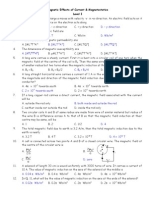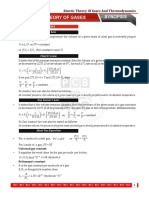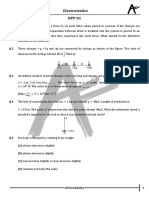15 Momentum Conservation
15 Momentum Conservation
Uploaded by
eltytanCopyright:
Available Formats
15 Momentum Conservation
15 Momentum Conservation
Uploaded by
eltytanOriginal Description:
Copyright
Available Formats
Share this document
Did you find this document useful?
Is this content inappropriate?
Copyright:
Available Formats
15 Momentum Conservation
15 Momentum Conservation
Uploaded by
eltytanCopyright:
Available Formats
Name: Period:
Momentum-Conservation
1. A 1.2-kilogram block and a 1.8-kilogram block are 4. Ball A of mass 5.0 kilograms moving at 20 meters per
initially at rest on a frictionless, horizontal surface. second collides with ball B of unknown mass moving
When a compressed spring between the blocks is re- at 10 meters per second in the same direction. After
leased, the 1.8-kilogram block moves to the right at the collision, ball A moves at 10 meters per second
2.0 meters per second, as shown. and ball B at 15 meters per second, both still in the
same direction. What is the mass of ball B?
1. 6.0 kg
2. 2.0 kg
3. 10 kg
4. 12 kg
5. In the diagram below, scaled vectors represent the
What is the speed of the 1.2-kilogram block after momentum of each of two masses, A and B, slid-
the spring is released? ing toward each other on a frictionless, horizontal
1. 1.4 m/s surface.
2. 2.0 m/s
3. 3.0 m/s
4. 3.6 m/s
Which scaled vector best represents the momentum
Base your answers to questions 2 and 3 on the informa- of the system after the masses collide?
tion below.
An 8.00-kilogram ball is fired horizontally from a 1.00
× 103-kilogram cannon initially at rest. After hav-
ing been fired, the momentum of the ball is 2.40 × 103
kilogram∙meters per second east. [Neglect friction.] 6. At the circus, a 100-kilogram clown
is fired 15 meters per second from a
2. Calculate the magnitude of the cannon’s velocity 500-kilogram cannon. What is the
after the ball is fired. [Show all work, including the recoil speed of the cannon?
equation and substitution with units.] 1. 75 m/s
2. 15 m/s
3. 3.0 m/s
4. 5.0 m/s
7. A woman with horizontal velocity v1 jumps off a dock
into a stationary boat. After landing in the boat, the
woman and the boat move with velocity v2. Com-
pared to velocity v1, velocity v2 has
1. the same magnitude and the same direction
2. the same magnitude and the opposite direction
3. smaller magnitude and the same direction
4. larger magnitude and the same direction
3. Identify the direction of the cannon’s velocity after
the ball is fired.
APlusPhysics: Momentum-Conservation MOM.B1 Page 75
Name: Period:
Momentum-Conservation
8. On a snow-covered road, a car with a mass of 1.1×103 11. Which two quantities can be expressed using the
kilograms collides head-on with a van having a mass of same units?
2.5×103 kilograms traveling at 8.0 meters per second. 1. energy and force
As a result of the collision, the vehicles lock together 2. impulse and force
and immediately come to rest. Calculate the speed 3. momentum and energy
of the car immediately before the collision. [Neglect 4. impulse and momentum
friction.] [Show all work, including the equation and
substitution with units.] 12. A 3.1-kilogram gun initially at rest is free to move.
When a 0.015-kilogram bullet leaves the gun with a
speed of 500 meters per second, what is the speed of
the gun?
1. 0.0 m/s
2. 2.4 m/s
3. 7.5 m/s
4. 500 m/s
Base your answers to questions 13 and 14 on the infor-
mation below. Show all work, including the equation
and substitution with units.
9. A 3.0-kilogram steel block is at rest on a frictionless
horizontal surface. A 1.0-kilogram lump of clay is A 1200-kilogram car moving at 12 meters per second
propelled horizontally at 6.0 meters per second to- collides with a 2300-kilogram car that is waiting at rest
ward the block as shown in the diagram below. at a traffic light. After the collision, the cars lock togeth-
er and slide. Eventually, the combined cars are brought to
rest by a force of kinetic friction as the rubber tires slide
across the dry, level asphalt road surface.
13. Calculate the speed of the locked-together cars im-
mediately after the collision.
Upon collision, the clay and steel block stick together
and move to the right with a speed of
1. 1.5 m/s
2. 2.0 m/s
3. 3.0 m/s
4. 6.0 m/s
10. A 1.0-kilogram laboratory cart moving with a veloc-
ity of 0.50 meter per second due east collides with and 14. Calculate the magnitude of the frictional force that
sticks to a similar cart initially at rest. After the colli- brings the locked-together cars to rest.
sion, the two carts move off together with a velocity of
0.25 meter per second due east. The total momentum
of this frictionless system is
1. zero before the collision
2. zero after the collision
3. the same before and after the collision
4. greater before the collision than after the colli-
sion.
Page 76 MOM.B1 APlusPhysics: Momentum-Conservation
Name: Period:
Momentum-Conservation
15. The diagram below represents two masses before and after they collide. Before the collision, mass mA is moving
to the right with speed v, and mass mB is at rest. Upon collision, the two masses stick together.
Which expression represents the speed, v’, of the masses after the collision? [Assume no outside forces are acting
on mA or mB.]
16. In the diagram below, a block of mass M initially at rest on a frictionless horizontal surface is struck by a bullet
of mass m moving with a horizontal velocity v.
What is the velocity of the bullet-block system after the bullet embeds itself in the block?
17. When a 1.0-kilogram cart moving with a speed of 18. The diagram below shows an 8.0-kilogram cart
0.50 meter per second on a horizontal surface col- moving to the right at 4.0 meters per second about
lides with a second 1.0-kilogram cart initially at rest, to make a head-on collision with a 4.0-kilogram cart
the carts lock together. What is the speed of the moving to the left at 6.0 meters per second.
combined carts after the collision? [Neglect friction.]
1. 1.0 m/s
2. 0.50 m/s
3. 0.25 m/s
4. 0 m/s
After the collision, the 4.0-kilogram cart moves to the
right at 3.0 meters per second. What is the velocity of
the 8.0-kilogram cart after the collision?
1. 0.50 m/s left
2. 0.50 m/s right
3. 5.5 m/s left
4. 5.5 m/s right
APlusPhysics: Momentum-Conservation MOM.B1 Page 77
Name: Period:
Momentum-Conservation
19. A 7.28-kilogram bowling ball traveling 8.50 meters
per second east collides head-on with a 5.45-kilo-
gram bowling ball traveling 10.0 meters per second
west. Determine the magnitude of the total momen-
tum of the two-ball system after the collision.
Page 78 MOM.B1 APlusPhysics: Momentum-Conservation
You might also like
- Neet 2022 Abroad Paper (Solved)Document36 pagesNeet 2022 Abroad Paper (Solved)NinaNo ratings yet
- 14 Momentum ImpulseDocument4 pages14 Momentum ImpulseeltytanNo ratings yet
- Grade 8 Module 1 - Newtons Law of MotionDocument24 pagesGrade 8 Module 1 - Newtons Law of Motionjohn charles garaldeNo ratings yet
- AatomsDocument22 pagesAatomsDEEPTHI VikramNo ratings yet
- O Level Physics Formula SheetDocument2 pagesO Level Physics Formula SheeteltytanNo ratings yet
- Phy Neet Revision Series Laws of Motion PDFDocument73 pagesPhy Neet Revision Series Laws of Motion PDFhamidNo ratings yet
- Force Word Problems and SolutionsDocument5 pagesForce Word Problems and SolutionsMedielyn Baldelovar100% (2)
- Testbank Chapter15Document11 pagesTestbank Chapter15AnaMendezNo ratings yet
- Abroad NEET2022 - NEET QUICKDocument25 pagesAbroad NEET2022 - NEET QUICKpadhi8480No ratings yet
- CW - 10 (Inspire Test Series 2024)Document20 pagesCW - 10 (Inspire Test Series 2024)Christopher Nolan100% (1)
- Atomic Structure Practice Sheet 1Document7 pagesAtomic Structure Practice Sheet 1godknows970299No ratings yet
- Bottom of Pyramid - Test # 22 - Mechanical Properties of SolidsDocument6 pagesBottom of Pyramid - Test # 22 - Mechanical Properties of SolidsJay PatelNo ratings yet
- 05 - Work, Energy and PowerDocument6 pages05 - Work, Energy and PowerAñîkët KãmãlNo ratings yet
- Medisquad Classes - Emi Cws 1,2, 3Document12 pagesMedisquad Classes - Emi Cws 1,2, 3ENGLISH MEDIUMNo ratings yet
- 24 Circuits ResistanceDocument6 pages24 Circuits ResistanceeltytanNo ratings yet
- 02.electrostatic Potential and Capacitance-FDocument50 pages02.electrostatic Potential and Capacitance-Fmahlom06No ratings yet
- Chapter - 8 - Simple Harmonic MotionDocument12 pagesChapter - 8 - Simple Harmonic MotionMohammed Aftab Ahmed0% (1)
- Check Your Grasp Exercise-I: Allen Thermodynamics ThermodynamicsDocument14 pagesCheck Your Grasp Exercise-I: Allen Thermodynamics ThermodynamicsMOHITNo ratings yet
- JR M1 - Mechanical Properties of Fluids (10-11-2023)Document3 pagesJR M1 - Mechanical Properties of Fluids (10-11-2023)Medhamsh ReddyNo ratings yet
- Iit (M+a) & Jee Mains Only-Diwali Assignment-XiDocument60 pagesIit (M+a) & Jee Mains Only-Diwali Assignment-XiSara WolfNo ratings yet
- 12th Physics (MCQS, 1 Mark Question)Document27 pages12th Physics (MCQS, 1 Mark Question)Prajwal MahadikNo ratings yet
- Fluid Mechanics - DPP 01 - Varun JEE Advanced 2024Document5 pagesFluid Mechanics - DPP 01 - Varun JEE Advanced 2024Ekas100% (1)
- Prof. P.C.Thomas Classes & Chaithanya Classes: NEET & JEE Mains 2013-2014 Special Test No. 1 PHYSICS First YearDocument2 pagesProf. P.C.Thomas Classes & Chaithanya Classes: NEET & JEE Mains 2013-2014 Special Test No. 1 PHYSICS First YearGokul Krishna MNo ratings yet
- Alternating CurrentDocument24 pagesAlternating Currentdigital pathshalaNo ratings yet
- Projectile Motion - Quesiton BankDocument5 pagesProjectile Motion - Quesiton BankSaήjaγKsNo ratings yet
- Chapter - 14 - ElectrostaticsDocument29 pagesChapter - 14 - ElectrostaticsMohammed Aftab Ahmed100% (1)
- Mechanical Properties Class 11 NotesDocument15 pagesMechanical Properties Class 11 NotesOther PurposesNo ratings yet
- 23 Circuits CurrentDocument2 pages23 Circuits CurrenteltytanNo ratings yet
- Collision DPP 01-MergeDocument10 pagesCollision DPP 01-MergeRajNo ratings yet
- CH 7Document30 pagesCH 7terasaini77No ratings yet
- Magnetic Effects of Currents and MagnetostaticsDocument23 pagesMagnetic Effects of Currents and MagnetostaticsMunish Dogra100% (1)
- 14 Dual Nature of Radiation and Matter15892002561589278747Document34 pages14 Dual Nature of Radiation and Matter15892002561589278747Alisha KukrejaNo ratings yet
- KTG ThermodynamicsDocument36 pagesKTG ThermodynamicsSatyajit ManeNo ratings yet
- 70-DPP Wave OpticsDocument2 pages70-DPP Wave OpticsDebasree PalNo ratings yet
- CH 2Document21 pagesCH 2terasaini77No ratings yet
- Magnetic Effects of CurrentsDocument41 pagesMagnetic Effects of CurrentsV V Satyanarayana PasupuletiNo ratings yet
- Matter-Wave Exercise 1 - 4 Module-6Document14 pagesMatter-Wave Exercise 1 - 4 Module-6Raju SinghNo ratings yet
- 212 - Problem Set 3Document2 pages212 - Problem Set 3everyoneMDNo ratings yet
- VPT (Cet) 03 PhysicsDocument9 pagesVPT (Cet) 03 Physicsaishwarya kadamNo ratings yet
- DPP - 01 - ElectrostaticsDocument4 pagesDPP - 01 - ElectrostaticsPubg prakhar PrakharNo ratings yet
- STD 12 Physics 2 Board Question Paper Maharashtra BoardDocument6 pagesSTD 12 Physics 2 Board Question Paper Maharashtra BoardTashvi Kulkarni100% (1)
- Electric Current PaperDocument11 pagesElectric Current Papermanish kant nagarNo ratings yet
- Work, Energy and PowerDocument3 pagesWork, Energy and PowerUJJVAL GAHOINo ratings yet
- Introduction of Physical Units and Dimensions - Assignment 01 Solution Notes - Chapter - 2 Units & Measurements (Physics)Document9 pagesIntroduction of Physical Units and Dimensions - Assignment 01 Solution Notes - Chapter - 2 Units & Measurements (Physics)ManishNo ratings yet
- 22a. Gravitation (Neon) GKK GaruDocument31 pages22a. Gravitation (Neon) GKK GaruPathan KausarNo ratings yet
- II Puc Physics Board MaterialDocument170 pagesII Puc Physics Board MaterialMadhav SahNo ratings yet
- Kinematics Booklet. PDFDocument44 pagesKinematics Booklet. PDFUlhas BuchakeNo ratings yet
- Physics: DPP - Daily Practice ProblemsDocument3 pagesPhysics: DPP - Daily Practice Problemslalithasaranya018No ratings yet
- Chapter 3 Motion in A Straight LineDocument31 pagesChapter 3 Motion in A Straight LinePankaj ChhabraNo ratings yet
- Alternating Current - Ex # 1 - 4Document19 pagesAlternating Current - Ex # 1 - 4Sagar AroraNo ratings yet
- 12 Electricity and Magnetisium - 1Document33 pages12 Electricity and Magnetisium - 1Harsh GuptaNo ratings yet
- Practice Test For NeetDocument13 pagesPractice Test For NeetMohammed Aftab AhmedNo ratings yet
- CH 6Document19 pagesCH 6terasaini77No ratings yet
- 06 - Electromagnetic InductionDocument16 pages06 - Electromagnetic InductionKindman KindmanNo ratings yet
- PhysicsDocument98 pagesPhysicsSaravanan BNo ratings yet
- MCQ's Chap 20Document3 pagesMCQ's Chap 20Arham MunirNo ratings yet
- Simple Harmonic Motion Multiple Choice-2013!07!11Document5 pagesSimple Harmonic Motion Multiple Choice-2013!07!11Vishal NanwaniNo ratings yet
- Electromegnatic Induction McqsDocument2 pagesElectromegnatic Induction McqsKhan TahirNo ratings yet
- Physics MCQ For SSC Exams 1692670949173 OBDocument9 pagesPhysics MCQ For SSC Exams 1692670949173 OBMata BharatNo ratings yet
- Em Waves Lec3,4,5Document63 pagesEm Waves Lec3,4,5Japjit SinghNo ratings yet
- 06 System of Particles and Rotational MotionDocument3 pages06 System of Particles and Rotational MotionMUHAMMED ANAS KNo ratings yet
- 11gmem0801 1715689917Document37 pages11gmem0801 1715689917harshilvasani3No ratings yet
- Magnetism (Sheet 1)Document14 pagesMagnetism (Sheet 1)Arush SinghalNo ratings yet
- Modern Physics (JEE MAIN Online) PDFDocument24 pagesModern Physics (JEE MAIN Online) PDFAnanya DwivediNo ratings yet
- Physics Exam 3Document6 pagesPhysics Exam 3Janeth SalazarNo ratings yet
- Lesson Plan: Lesson: Projectiles Without Air ResistanceDocument4 pagesLesson Plan: Lesson: Projectiles Without Air ResistanceeltytanNo ratings yet
- Lesson Plan: © 2003 Ministry of Education Malaysia. All Rights ReservedDocument3 pagesLesson Plan: © 2003 Ministry of Education Malaysia. All Rights ReservedeltytanNo ratings yet
- Lesson Plan: Lesson: Rectilinear Motion: Graphical Representation and InterpretationDocument3 pagesLesson Plan: Lesson: Rectilinear Motion: Graphical Representation and InterpretationeltytanNo ratings yet
- Lesson Plan: Lesson: Units and DimensionsDocument5 pagesLesson Plan: Lesson: Units and Dimensionseltytan100% (1)
- AL Applied Mathematics 1989 Paper1+2 (E)Document7 pagesAL Applied Mathematics 1989 Paper1+2 (E)eltytanNo ratings yet
- AL Applied Mathematics 1994 Paper1+2 (MS) PDFDocument26 pagesAL Applied Mathematics 1994 Paper1+2 (MS) PDFeltytanNo ratings yet
- Phy Graphical Method P2Document1 pagePhy Graphical Method P2eltytanNo ratings yet
- AL Applied Mathematics 1987 Paper1+2 (E)Document6 pagesAL Applied Mathematics 1987 Paper1+2 (E)eltytanNo ratings yet
- Phy Electronics P2Document5 pagesPhy Electronics P2eltytanNo ratings yet
- Phy Radioactivity P2Document2 pagesPhy Radioactivity P2eltytanNo ratings yet
- Electrostatics: Physics-MC/Electrostatics/By Lee Siu Hin Page 1 of 3Document3 pagesElectrostatics: Physics-MC/Electrostatics/By Lee Siu Hin Page 1 of 3eltytanNo ratings yet
- Phy Radioactivity P22Document5 pagesPhy Radioactivity P22eltytanNo ratings yet
- Electronics: Physics-MC/Electronics/By Lee Siu Hin Page 1 of 11Document11 pagesElectronics: Physics-MC/Electronics/By Lee Siu Hin Page 1 of 11eltytanNo ratings yet
- Buoyancy and FloatationDocument27 pagesBuoyancy and FloatationProf. Avinash Mahale85% (13)
- Hookes Work EnergyDocument4 pagesHookes Work EnergykatieNo ratings yet
- Electro Magnetic FieldDocument4 pagesElectro Magnetic FieldAnanya ParameswaranNo ratings yet
- EEEB253 Chap5 v02Document11 pagesEEEB253 Chap5 v02zawir gulamNo ratings yet
- Weekly Assessment Number 2Document1 pageWeekly Assessment Number 2Marissa FontanilNo ratings yet
- Elastic Collision FormulaDocument5 pagesElastic Collision FormulaSheena AntonioNo ratings yet
- Revision QuestionsDocument3 pagesRevision QuestionsPriya Suresh KumarNo ratings yet
- 4.1 Electric Flux Lines and Flux Density: TopicsDocument9 pages4.1 Electric Flux Lines and Flux Density: TopicsxoxoNo ratings yet
- INSP Champs 2022 NLM 1 FinalDocument26 pagesINSP Champs 2022 NLM 1 Finalsamarth guptaNo ratings yet
- Physics F 3 Term 2Document19 pagesPhysics F 3 Term 2tapceNo ratings yet
- Chemistry Pennium LabDocument2 pagesChemistry Pennium Labanon-5794470% (1)
- PHYS320 Week 5 Homework AnswersDocument11 pagesPHYS320 Week 5 Homework AnswersWesNamtrowNo ratings yet
- 2021-1 일반공학물리 중간고사 문제지Document5 pages2021-1 일반공학물리 중간고사 문제지인형원No ratings yet
- Lecture 1 - Introduction and Rectilinear MotionDocument39 pagesLecture 1 - Introduction and Rectilinear Motionorenchladee100% (1)
- Hooke's Law AssessmentDocument2 pagesHooke's Law Assessmentmarklegaspi151No ratings yet
- Turning Effect of ForcesDocument49 pagesTurning Effect of ForcesLinn TanNo ratings yet
- G9 - 4th Quarter With Answer KeyDocument3 pagesG9 - 4th Quarter With Answer KeyKristi Ana del MundoNo ratings yet
- UP HW CH 7 SDocument4 pagesUP HW CH 7 SVei AdoptanteNo ratings yet
- Test # 01 (CH # 12)Document1 pageTest # 01 (CH # 12)paggal janNo ratings yet
- Stabilization of SoilDocument24 pagesStabilization of SoilModestus SangaNo ratings yet
- Moments of ForcesDocument8 pagesMoments of ForcestopcatNo ratings yet
- GE6253 - 2 Mark Question Engineering MechanicsDocument6 pagesGE6253 - 2 Mark Question Engineering MechanicsstkrNo ratings yet
- 2017 Unit 3 Physics KTT 5 Newton's Laws Question BookDocument15 pages2017 Unit 3 Physics KTT 5 Newton's Laws Question BookSamana GulzariNo ratings yet
- Ship Design & Construction - SNAMEDocument9 pagesShip Design & Construction - SNAMEBrian FreemanNo ratings yet
- Electromagnetism NotesDocument17 pagesElectromagnetism NotesNikolasNo ratings yet






































































































